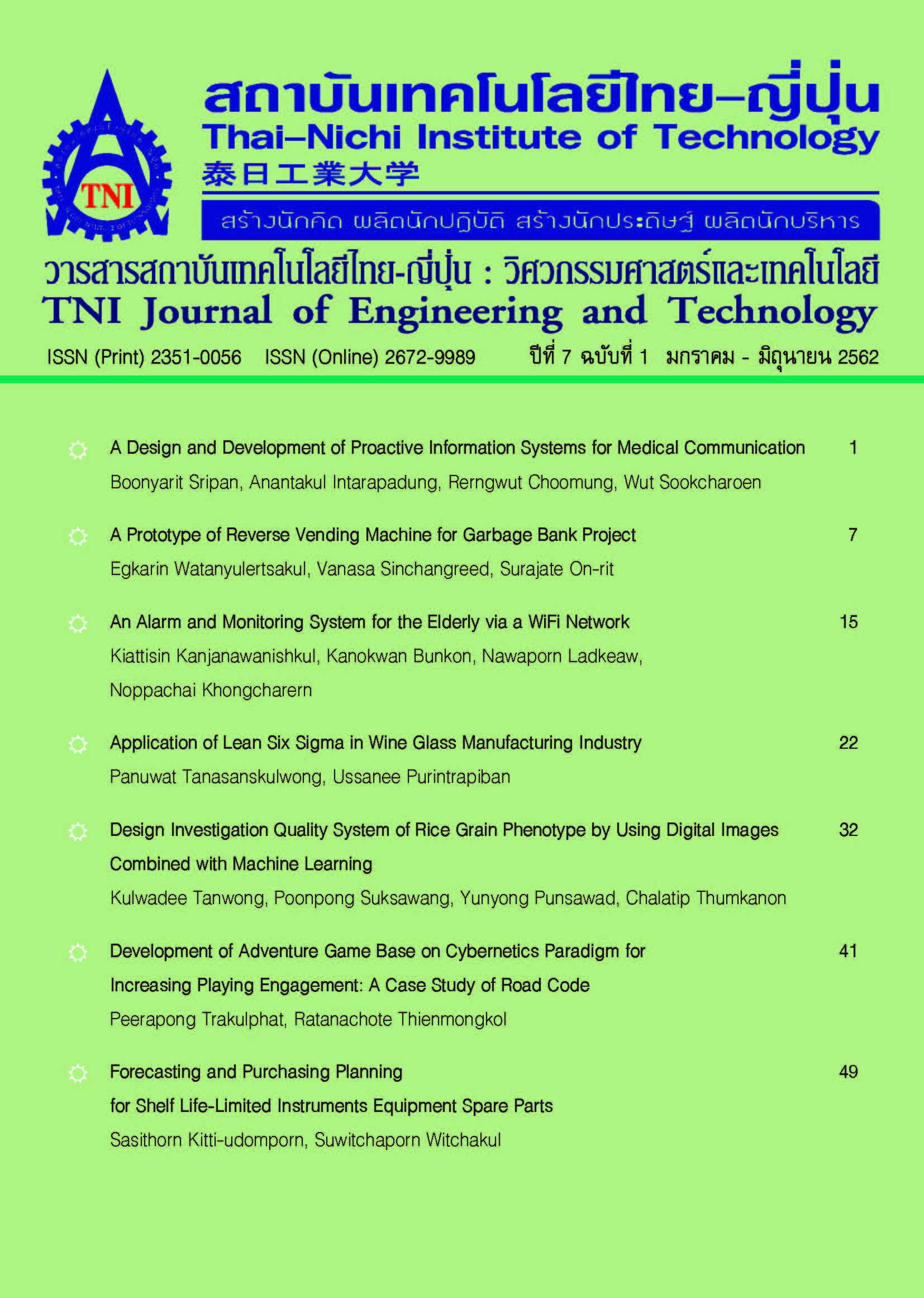Strategic Approach to Adopt ICT in SMEs
Main Article Content
บทคัดย่อ
This study investigates the success and failure factors of ICT adoption and usage in Thailand and Japan. In addition, this research aims to establish, derive and come up with an indicative model of identified factors and framework related to successfulness in ICT adoption in SMEs. The factors affecting the risks of ICT adoption faced by SMEs organization consists of three predictors: risk assessment, clear scope of the ICT project and internal management response to project. Finding factors will help the project team estimate the effectiveness of current controls and suggests whether each ICT adoption and usage is potentially failed, potentially succeed, or potentially over-controlled.
Article Details
นโยบายการรับบทความ
กองบรรณาธิการวารสารสถาบันเทคโนโลยีไทย-ญี่ปุ่น มีความยินดีรับบทความจากอาจารย์ประจำ และผู้ทรงคุณวุฒิในสาขาวิศวกรรมศาสตร์และเทคโนโลยี ที่เขียนเป็นภาษาไทยหรือภาษาอังกฤษ ซึ่งผลงานวิชาการที่ส่งมาขอตีพิมพ์ต้องไม่เคยเผยแพร่ในสิ่งพิมพ์อื่นใดมาก่อน และต้องไม่อยู่ในระหว่างการพิจารณาของวารสารอื่นที่นำส่ง ดังนั้นผู้สนใจที่จะร่วมเผยแพร่ผลงานและความรู้ที่ศึกษามาสามารถนำส่งบทความได้ที่กองบรรณาธิการเพื่อเสนอต่อคณะกรรมการกลั่นกรองบทความพิจารณาจัดพิมพ์ในวารสารต่อไป ทั้งนี้บทความที่สามารถเผยแพร่ได้ประกอบด้วยบทความวิจัย ผู้สนใจสามารถศึกษาและจัดเตรียมบทความจากคำแนะนำสำหรับผู้เขียนบทความ
การละเมิดลิขสิทธิ์ถือเป็นความรับผิดชอบของผู้ส่งบทความโดยตรง บทความที่ได้รับการตีพิมพ์ต้องผ่านการพิจารณากลั่นกรองคุณภาพจากผู้ทรงคุณวุฒิและได้รับความเห็นชอบจากกองบรรณาธิการ
ข้อความที่ปรากฏภายในบทความของแต่ละบทความที่ตีพิมพ์ในวารสารวิชาการเล่มนี้ เป็น ความคิดเห็นส่วนตัวของผู้เขียนแต่ละท่าน ไม่เกี่ยวข้องกับสถาบันเทคโนโลยีไทย-ญี่ปุ่น และคณาจารย์ท่านอื่น ๆ ในสถาบัน แต่อย่างใด ความรับผิดชอบด้านเนื้อหาและการตรวจร่างบทความแต่ละบทความเป็นของผู้เขียนแต่ละท่าน หากมีความผิดพลาดใด ๆ ผู้เขียนแต่ละท่านจะต้องรับผิดชอบบทความของตนเองแต่ผู้เดียว
กองบรรณาธิการขอสงวนสิทธิ์มิให้นำเนื้อหา ทัศนะ หรือข้อคิดเห็นใด ๆ ของบทความในวารสารสถาบันเทคโนโลยีไทย-ญี่ปุ่น ไปเผยแพร่ก่อนได้รับอนุญาตจากผู้นิพนธ์ อย่างเป็นลายลักษณ์อักษร ผลงานที่ได้รับการตีพิมพ์ถือเป็นลิขสิทธิ์ของวารสารสถาบันเทคโนโลยีไทย-ญี่ปุ่น
ผู้ประสงค์จะส่งบทความเพื่อตีพิมพ์ในวารสารวิชาการ สถาบันเทคโนโลยีไทย-ญี่ปุ่น สามารถส่ง Online ที่ https://www.tci-thaijo.org/index.php/TNIJournal/ โปรดสมัครสมาชิก (Register) โดยกรอกรายละเอียดให้ครบถ้วนหากต้องการสอบถามข้อมูลเพิ่มเติมที่
- กองบรรณาธิการ วารสารสถาบันเทคโนโลยีไทย-ญี่ปุ่น
- ฝ่ายวิจัยและนวัตกรรม สถาบันเทคโนโลยีไทย-ญี่ปุ่น
เลขที่ 1771/1 สถาบันเทคโนโลยีไทย-ญี่ปุ่น ซอยพัฒนาการ 37-39 ถนนพัฒนาการ แขวงสวนหลวง เขตสวนหลวง กรุงเทพมหานคร 10250 ติดต่อกับคุณพิมพ์รต พิพัฒนกุล (02) 763-2752 , คุณจุฑามาศ ประสพสันติ์ (02) 763-2600 Ext. 2402 Fax. (02) 763-2754 หรือ E-mail: JEDT@tni.ac.th
เอกสารอ้างอิง
J. Eaempoom and A, Tangviroon, “SMEs Statistic in Thailand,” Bank of Thailand, [Online]. Available: https://www.bot.or.th/Thai/Statistics/Articles/DocLib_StatinFocus/SMEs.pdf [Accessed: 22-May-2018].
OSMEP Thailand, “E-BUSINESS AND SMEs,” [Online]. Available: https://www.oecd.org/cfe/smes/31919255.pdf [Accessed: 2-May-2018].
G. K. Winley and S. Nontakao, “Factors Affecting the Success of Enterprise Resource Planning Systems in Thailand,” Science, Engineering and Health Studies, vol. 9, No. 2, pp. 20-39, 2015.
J. A. Keizer, L. Dijkstra, and J. I. M. Halman, “Explaining innovative efforts of SMEs.: An exploratory survey among SMEs in the mechanical and electrical engineering sector in The Netherlands,” Technovation, vol. 22, no. 1, pp. 1–13, Jan. 2002.
D. Peter F., Innovation and entrepreneurship. London: Routledge, 2015.
Organisation For Economic Co-operation And Development, “ICT,E-BUSINESS AND SMEs,” in Promoting entrepreneurship and innovative SMEs in a global economy: towards a more responsible and inclusive globalization, Istanbul, Turkey, 2004.
A. Jaafari, and K. Manivong, “Towards a smart project management information system,” International journal of project management, Vol. 16 no. 4, pp. 249-265, 1998.
C. Bredillet, F. Yatim, and P. Ruiz, “Project management deployment: The role of cultural factors,” International Journal of Project Management, Vol. 28, No. 2, pp. 183-193, 2010.
T. Ramayah, N.S. Ling, S.K. Taghizadeh and S.A. Rahman, “Factors influencing SMEs website continuance intention in Malaysia,” Telematics and Informatics, Vol. 33, No. 1, pp. 150-164 , 2016.
A. Tovar, “SME Technology attitudes and beliefs: An exploratory study of information technology adoption behavior,” Ph.D. dissertation (Information Systems and Technology), University of Phoenix, Phoenix, United States, 2012.
A. De Wit, “Measurement of project success,” International journal of project management, Vol.6, No. 3, pp.164-170, 1988.
A.K. Munns, and B.F. Bjeirmi, “The role of project management in achieving project success,” International journal of project management, Vol.14, No. 2, pp. 81-87, 1996.
R. Turner, A. Ledwith and J. Kelly, “Project management in small to medium-sized enterprises: Matching processes to the nature of the firm,” International journal of project management, Vol. 28, No. 8, pp. 744-755, 2010.
K. De Bakker, A. Boonstra and H. Wortmann, “Does risk management contribute to IT project success? A meta-analysis of empirical evidence,” International Journal of Project Management, Vol. 28, No. 5, pp. 493-503, 2010.
X. Xin. "Document Management in Project Development," in 4th International Conference on Education, Management, Arts, Economics and Social Science (ICEMAESS 2017), Sanya, China, 2017.
F. Hartman and R. Ashrafi, “Development of the SMARTTM Project Planning framework,” International Journal of Project Management, Vol. 22 No. 6, pp. 499-510, 2004.
Paragon, “10 Benefits of working with an IT consultant.” [Online]. Available: https://www. paragon.net/benefits-it-consultant [Accessed: 22-May-2018].
B. M. Sadowski, “Advanced users and the adoption of high speed broadband: Results of a living lab study in the Netherlands,” Technological Forecasting and Social Change, vol. 115, pp. 1–14, Feb. 2017.
B. R. Eichhorn, “The impact of user involvement on information system projects.” [Online]. Available: https://etd.ohiolink.edu/!etd.send_file?accession= csu1410793063&disposition=inline [Accessed: 20-May-2018].
M. A. Harris, and H.R. Weistrofferv, “A new look at the relationship between user involvement in systems development and system success,” Communications of the Association for Information Systems, Vol. 24, No. 1, pp. 739-756, 2009.
J. W. Creswell, Research Design: Qualitative, Quantitative and Mixed Methods Approaches, 4th ed. Thousand Oaks: SAGE Publications, 2014.
H. F. Kaiser, “The varimax criterion for analytic rotation in factor analysis,” Psychometrika, vol. 23, no. 3, pp. 187–200, Sep. 1958.
IBM, “IBM SPSS Modeller 17 Algorithms Guide.” [Online]. Available: htttp://public.dhe.ibm.com/software/analytics/spss/documentation/modeler/17.0/en/AlgorithmsGuide.pdf. [Accessed: 22-May-2018].


